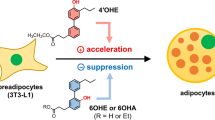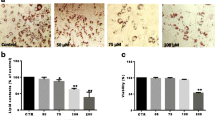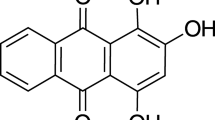Abstract
This study aimed to investigate the mechanism of intervening type II diabetes by flavonoid compound from Agrimonia pilosa Ledeb in vitro. We found flavonoid compound exhibited moderate peroxisome proliferator-activated receptor gamma agonist activity which was lower than that of rosiglitazone by luciferase reporter assay. 3T3-L1 cell differentiation was induced typically in the presence of various concentrations of flavonoid compound or pioglitazone for assaying insulin sensitization. We found that flavonoid compound effectively promoted 3T3-L1 preadipocyte differentiation and lipid deposition, but its intensity was lower than that of pioglitazone. Quantitative polymerase chain reaction assays showed that flavonoid compound promoted the expression of peroxisome proliferator-activated receptor gamma, CCAAT enhancer binding protein-α, and sterol regulatory element-binding protein 1 in a dose-dependent manner. As a result, the expressions of Glut4 and adiponectin were significantly enhanced. Additionally, the expressions of AP2 and lipoprotein lipase induced by flavonoid compound were lower than those by pioglitazone. These findings indicate that flavonoid compound from Agrimonia pilosa Ledeb exhibits the good property of partial peroxisome proliferator-activated receptor gamma agonism, and shares similar insulin-sensitizing effects with pioglitazone, but has lower adipogenic capacity. It is implied that flavonoid compound has a promising prospect of fighting insulin resistance as a partial agonist of peroxisome proliferator-activated receptor gamma.








Similar content being viewed by others
Abbreviations
- APL:
-
Agrimonia pilosa Ledeb
- FC:
-
Flavonoid compound
- HEK 293T cells:
-
Human embryonic kidney (HEK) 293T cells
- Q-PCR:
-
Quantitative polymerase chain reaction
- PPARγ:
-
Peroxisome proliferator-activated receptor gamma
- C/EBP-α:
-
CCAAT enhancer binding protein-α
- SREBP-1:
-
Sterol regulatory element-binding protein 1
- Glut4:
-
Glucose transporter
- LPL:
-
Lipoprotein lipase
- AP2:
-
Fat acid binding protein
- IR:
-
Insulin resistance
- TZDs:
-
Thiazolidinediones
- SPPARγMs:
-
Selective PPARγ modulators
- T2DM:
-
Type 2 diabetes
- TCM:
-
Traditional Chinese medicine
- FFA:
-
Free fatty acid
References
Bays H, Mandarino L, DeFronzo RA (2004) Role of the adipocyte, free fatty acids, and ectopic fat in pathogenesis of type 2 diabetes mellitus: peroxisomal proliferator-activated receptor agonists provide a rational therapeutic approach. J Clin Endocr Metab 89:463–478
Berger JP, Petro AE, Macnaul KL, Kelly LJ, Zhang BB, Richards K, Elbrecht A, Johnson BA, Zhou G, Doebber TW (2003) Distinct properties and advantages of a novel peroxisome proliferator-activated protein γ selective modulator. Mol Endocrinol 17:662–676
Bhalla K, Hwang BJ, Choi JH, Dewi R, Ou L, Mclenithan J, Twaddel W, Pozharski E, Stock J, Girnun GD (2011) N-acetylfarnesylcysteine is a novel class of peroxisome proliferator-activated receptor γ ligand with partial and full agonist activity in vitro and in vivo. J Biol Chem 286:41626–41635
Brozinick JT, McCoid SC, Reynolds TH, Nardone NA, Hargrove DM, Stevenson RW, Cushman SW, Gibbs EM (2001) GLUT4 overexpression in db/db mice dose-dependently ameliorates diabetes but is not a lifelong cure. Diabetes 50:593–600
Cariou B, Charbonnel B, Staels B (2012) Thiazolidinediones and PPARγ agonists: time for a reassessment. Trends Endocr Metab 23:205–215
Chi YS, Lim H, Park H, Kim HP (2003) Effects of wogonin, a plant flavone from Scutellaria radix, on skin inflammation: in vivo regulation of inflammation-associated gene expression. Biochem Pharmacol 66:1271–1278
Christensen KB, Petersen RK, Kristiansen K, Christensen LP (2010) Identification of bioactive compounds from flowers of black elder (Sambucus nigra L.) that activate the human peroxisome proliferator-activated receptor (PPAR) gamma. Phytother Res 24(S2):S129–S132
Fu Y, Luo N, Lopes-Virella MF (2000) Oxidized LDL induces the expression of ALBP/aP2 mRNA and protein in human THP-1 macrophages. J Lipid Res 41:2017–2023
Gijsbers L, van Eekelen HD, de Haan LH, Swier JM, Heijink NL, Kloet SK, Man HY, Bovy AG, Keijer J, Aarts JMM, van der Burg B, Rietjens IMC (2013) Induction of peroxisome proliferator-activated receptor gamma (PPARγ)-mediated gene expression by tomato (Solanum lycopersicum L.) extracts. J Agric Food Chem 61(14):3419
Goto TNH, Egawa K, Kim YI, Kato S, Taimatsu A, Sakamoto T, Ebisu S, Hohsaka T, Miyagawa H, Murakami S, Takahashi N, Kawada T (2011) Farnesyl pyrophosphate regulates adipocyte functions as an endogenous PPARγ agonist. Biochem J 438:111–119
Huang THW, Kota BP, Razmovski V, Roufogalis BD (2005) Herbal or natural medicines as modulators of peroxisome proliferator activated receptors and related nuclear receptors for therapy of metabolic syndrome. Basic Clin Pharmacol Toxicol 96:3–14
Johmura Y (2007) Characterization of novel genes regulating adipocyte differentiation. Yakugaku Zasshi 127:135–142
Lago RM, Singh PP, Nesto RW (2007) Congestive heart failure and cardiovascular death in patients with prediabetes and type 2 diabetes given thiazolidinediones: a meta-analysis of randomized clinical trials. Lancet 370:1129–1136
Lara-Castro C, Fu Y, Chung BH, Garvey WT (2007) Adiponectin and the metabolic syndrome: mechanisms mediating risk for metabolic and cardiovascular disease. Curr Opin Lipidol 18:263–270
Lim Y, Kim I, Seo J (2007) In vitro activity of kaempferol isolated from the Impatiens balsamina alone and in combination with erythromycin or clindamycin against Propionibacterium acnes. J Microbiol 45:473–477
Liu X, Zhu LC, Tan J, Zhou XM, Xiao L, Yang X, Wang BC (2014) Glucosidase inhibitory activity and antioxidant activity of flavonoid compound and triterpenoid compound from Agrimonia Pilosa Ledeb. BMC Complement Altern Med 14:12
Masuoka N, Matsuda M, Kubo I (2012) Characterization of the antioxidant activity of flavonoids. Food Chem 131:541–545
Matsuda M, Shimomura I, Sata M, Arita Y, Nishida M, Maeda N, Kumada M, Okamoto Y, Nagaretani H, Nishizawa H (2002) Role of adiponectin in preventing vascular stenosis the missing link of adipo-vascular axis. J Biol Chem 277:37487–37491
Miller AR, Etgen GJ (2003) Novel peroxisome proliferator-activated receptor ligands for type 2 diabetes and the metabolic syndrome. Expert Opin Investig Drugs 12:1489–1500
Mosmann T (1983) Rapid colorimetric assay for cellular growth and survival: application to proliferation and cytotoxicity assays. J Immunol Methods 65:55–63
Motani A, Wang Z, Weiszmann J, McGee LR, Lee G, Liu Q, Staunton J, Fang Z, Fuentes H, Lindstrom M (2009) INT131: A selective modulator of PPARγ. J Mol Biol 386:1301–1311
Mueller M, Lukas B, Novak J, Simoncini T, Genazzani AR, Jungbauer A (2008) Oregano: a source for peroxisome proliferator-activated receptor gamma antagonists. J Agric Food Chem 56(24):11621–11630
Muoio DM, Newgard CB (2008) Molecular and metabolic mechanisms of insulin resistance and [beta] -cell failure in type 2 diabetes. Nat Rev Mol Cell Biol 9(3):193–205
Nugent CPJ, Whitehead JP, Savage D, Wentworth JM, Chatterjee VK, O’Rahilly S (2001) Potentiation of glucose uptake in 3T3-L1 adipocytes by PPAR gamma agonists is maintained in cells expressing a PPAR gamma dominant-negative mutant: evidence for selectivity in the downstream responses to PPAR gamma activation. Mol Endocrinol 15:1729–1738
Ouchi N, Walsh K (2007) Adiponectin as an anti-inflammatory factor. Clin Chim Acta 380:24–30
Pharmacopoeia Commission of People’s Republic of China (2015) Chinese Pharmacopoeia, Part I. Chemical Industry Press, Beijing, p 102–103
Rasouli N, Kern PA, Elbein SC, Sharma NK, Das SK (2012) Improved insulin sensitivity after treatment with PPARγ and PPARα ligands is mediated by genetically modulated transcripts. Pharmacogenet Genom 22:484–497
Rau O, Wurglics M, Dingermann T, Abdel-Tawab M, Schubert-Zsilavecz M (2006) Screening of herbal extracts for activation of the human peroxisome proliferator-activated receptor. Pharmazie 61:952–956
Rival Y, Stennevin A, Puech L, Rouquette A, Cathala C, Lestienne F, Dupont-Passelaigue E, Patoiseau J-F, Wurch T, Junquéro D (2004) Human adipocyte fatty acid-binding protein (aP2) gene promoter-driven reporter assay discriminates nonlipogenic peroxisome proliferator-activated receptor γ ligands. J Pharmacol Exp Ther 311:467–475
Saito T, Abe D, Sekiya K (2007) Nobiletin enhances differentiation and lipolysis of 3T3-L1 adipocytes. Biochem Biophys Res Commun 357:371–376
Saltiel AR, Olefsky JM (1996) Thiazolidinediones in the treatment of insulin resistance and type II diabetes. Diabetes 45:1661–1669
Schoonjans K, Peinado-Onsurbe J, Lefebvre A-M, Heyman RA, Briggs M, Deeb S, Staels B, Auwerx J (1996) PPARalpha and PPARγ activators direct a distinct tissue-specific transcriptional response via a PPRE in the lipoprotein lipase gene. EMBO J 15:5336–5348
Staels B, Fruchart JC (2005) Therapeutic roles of peroxisome proliferator–activated receptor agonists. Diabetes 54:2460–2470
Storch J, Thumser AE (2000) The fatty acid transport function of fatty acid-binding proteins. Mol Cell Biol 1486:28–44
Tontonoz P, Hu E, Graves RA, Budavari AI, Spiegelman BM (1994) mPPAR γ2: tissue-specific regulator of an adipocyte enhancer. Gene Dev 8:1224–1234
Tsao T-S, Burcelin R, Katz EB, Huang L, Charron MJ (1996) Enhanced insulin action due to targeted GLUT4 overexpression exclusively in muscle. Diabetes 45:28–36
Vijayalakshmi A, Tripura A, Ravichandiran V (2011) Development and evaluation of anti-acne products from Terminalia arjuna Bark. Int J ChemTech Res 3:320–327
Wu N, Zu Y, Fu Y, Kong Y, Zhao J, Li X, Li J, Wink M, Efferth T (2010) Antioxidant activities and xanthine oxidase inhibitory effects of extracts and main polyphenolic compounds obtained from Geranium sibiricum L. J Agric Food Chem 58:4737–4743
Wu Z, Bucher N, Farmer SR (1996) Induction of peroxisome proliferator-activated receptor γ during the conversion of 3T3 fibroblasts into adipocytes is mediated by C/EBPβ, C/EBPδ, and glucocorticoids. Mol Cell Biol 16:4128–4136
Acknowledgements
Thank Prof. Xiaoqiu Xiao (Chongqing Medical University) for the gift of 293T cells and Changhua Wang (Chongqing Academy of Chinese Materia Medica) for the verification of plant material. This work was supported by the Fundamental Research Funds for the Central Universities (106112015CDJXY230001), the Basic and Frontier Research Project of Chongqing (cstc2014jcyjA10097), and Three Gorges Natural Medicine Engineering Research Center of Chongqing University of Education (167011).
Author information
Authors and Affiliations
Corresponding authors
Ethics declarations
Conflict of interest
The authors declare that they have no competing interests.
Rights and permissions
About this article
Cite this article
Zhu, L., Tan, J., Lou, D. et al. The effects of flavonoid compound from Agrimonia pilosa Ledeb on promotting 3T3-L1 preadipocytes differentiation by activating PPARγ partially. Med Chem Res 26, 2920–2928 (2017). https://doi.org/10.1007/s00044-017-1991-x
Received:
Accepted:
Published:
Issue Date:
DOI: https://doi.org/10.1007/s00044-017-1991-x




